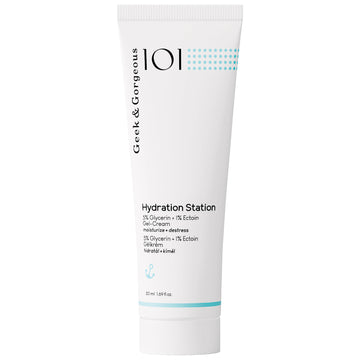Hydration Station
A light and refreshing gel-cream with hydrating gold standard Glycerin and skin-protecting superstar Ectoin for dewy, plump & healthy skin.
50 ml
Skin type: normal, combination, oily
Skin concern: can be used regardless of skin concern, especially recommended if your skin is prone to breakouts
Cruelty-free | Vegan | Fragrance & Essential oil free | Gluten-free | Malassezia-safe | Pregnancy-safe

Hydration Station
description
A refreshing, light gel cream textured moisturiser that goes beyond the basics, as it not only hydrates, but also protects and soothes the skin. A medium-amount of 5% Glycerin is enhanced by hydrators working in synergy with glycerin: a new-generation molecule called Isosorbide Dicaprylate and a sugar trio, trade named Aquaxyl, help the transportation of glycerin throughout the epidermis (by upregulating Aquaporin-3) and strengthen the skin barrier by stimulating the skin’s own ceramide production.
The 1% Ectoin in the formula hydrates & soothes the skin, while it also protects from all kinds of environmental stress, such as pollution, oxidative stress, blue & visible light. A good dose of two classic calming ingredients, Allantoin and Bisabolol further enhance the soothing ability of Hydration Station.
- 4.5-5.5 pH
- 5% Glycerin
- 1% Ectoin
What makes the formula of Hydration Station unique is also what is not in it. It avoids three super common ingredient groups that are found in almost all moisturisers: fatty alcohols, fatty acids and silicones. While there is absolutely nothing wrong with these ingredients (and we do use some of them in our other moisturiser, Happier Barrier), we know there are a few skin types bothered by these, and we know how hard it is to find a good product without them. If you find that most “normal” moisturisers break you out, or you have a skin issue related to Malassezia fungi (malassezia folliculitis, aka fungal acne or seborrheic dermatitis), Hydration Station could be your formula.
who is it for?
Pretty much anyone who is looking for a lightweight, soothing gel-cream for their normal, combination or oily skin. We especially recommend it if regular moisturisers tend to break you out, or you have a skin issue related to Malassezia fungi (malassezia folliculitis, aka fungal acne or seborrheic dermatitis).
- Skin type: normal, combination, oily skin
- Skin concern: can be used regardless of skin concern
- Texture: light gel-cream
how to use
Apply after serums in the AM and/or PM. Use as much or as little as your skin needs.
Shelf life: 24 months from production (unopened), 6 months PAO (period after opening)
ingreds & research
key ingreds:
Glycerin – A natural, water-binding moisturizer that can also be found in our skin. It is the gold standard, most proven humectant that goes beyond simple hydration. It keeps the skin lipids between our skin cells in a healthy (liquid crystal) state, protects against irritation, and helps to restore the barrier. 5% of Glycerin counts as a medium amount, ideal for combination-oily skin.
Ectoin – An amazing, all-around skin protectant. This well-researched, multi-functional active has antioxidant, anti-inflammatory, pollution & light protecting, skin hydrating, barrier repairing as well as anti-aging properties.
Isosorbide Dicaprylate – A modern skin hydrator and barrier builder molecule that works particularly well with Glycerin. It is known to upregulate Aquaporin-3, the important water & glycerin channels in the epidermis.
Xylitylglucoside + Anhydroxylitol + Xylitol – A sugar based humectant trio that works in synergy with glycerin to increase the skin’s water-binding capacity and strengthen the skin barrier.
Bisabolol + Allantoin – Two classic skincare ingredients known for their skin soothing abilities.
full inci list:
Aqua (Water), C15-19 Alkane, Glycerin, Caprylic/Capric Triglyceride, PEG/PPG/Polybutylene Glycol-8/5/3 Glycerin, Isosorbide Dicaprylate, Ectoin, Xylitylglucoside, Bisabolol, Allantoin, Anhydroxylitol, Xylitol, Hydroxyethyl Acrylate/Sodium Acryloyldimethyl Taurate Copolymer, Ammonium Acryloyldimethyltaurate/VP Copolymer, Glucose, Citric Acid, Tocopherol, Ethylhexylglycerin, Phenoxyethanol
research:
Leslie Baumann, MD, Cosmetic Dermatology, 2nd edition, Glycerin - pages 275
Dry Skin and Moisturizers: Chemistry and Function, Marie Loden, Howard I. Maibach, chapter 20: Glycerol — Just a Moisturizer? Biological and Biophysical Effects
Buenger, J., and H. Driller. "Ectoin: an effective natural substance to prevent UVA-induced premature photoaging." Skin Pharmacology and Physiology 17.5 (2004): 232-237.
Heinrich, Ulrike, B. Garbe, and H. Tronnier. "In vivo assessment of Ectoin: a randomized, vehicle-controlled clinical trial." Skin pharmacology and physiology 20.4 (2007): 211-218.
Graf, Ruediger, et al. "The multifunctional role of ectoine as a natural cell protectant." Clinics in dermatology 26.4 (2008): 326-333.
Chaudhuri, R. K., and K. Bojanowski. "Improvement of hydration and epidermal barrier function in human skin by a novel compound isosorbide dicaprylate." International journal of cosmetic science 39.5 (2017): 518-526.
Leite e Silva, Vânia Rodrigues, et al. "Hydrating effects of moisturizer active compounds incorporated into hydrogels: in vivo assessment and comparison between devices." Journal of cosmetic dermatology 8.1 (2009): 32-39.






